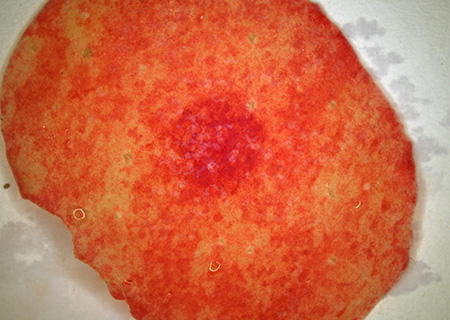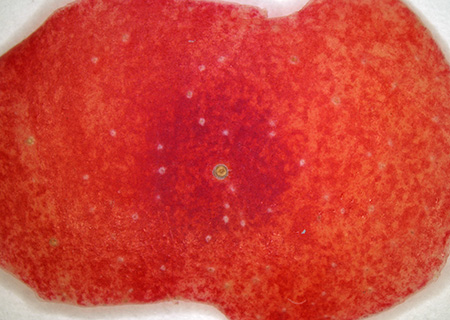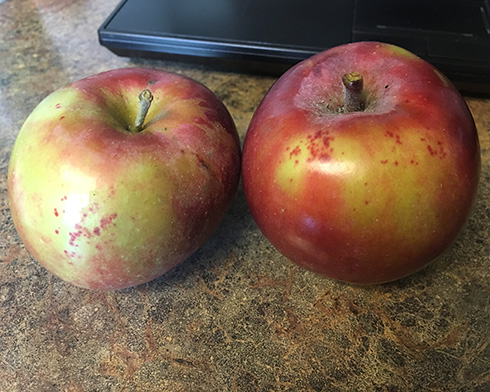Grand Rapids area apple maturity report – Sept. 19, 2018
Some maturity parameters are moving very quickly in apples, but do they tell the whole story?

General comments
Week three of our Grand Rapids, Michigan, area apple maturity sampling continues to show fruits with higher than expected starch clearing, but ethylene is low, and these two parameters don’t correlate as usual this season. This is most likely due to the heat we’ve experienced all summer and into harvest. It is important to note the starch-iodine test is only one of several maturity parameters to measure to help you decide on a best harvest date. See the new article from Randy Beaudry on harvesting in the heat for more details.
For the Grand Rapids area, apple maturity seems to continue to run close to our 2018 predicted apple harvest dates with some sites being slightly ahead. Our predicted harvest dates are for PEAK harvest, so some fruits might be ready ahead or behind these dates as we move through maturity. When we sample apple varieties, we try our best to collect random samples from blocks untreated with harvest management products.
Last week, I shared pictures of strange spots on apples here and there. I have since been able to identify the causes.
These Gala (and several other samples) have been showing up with San Jose Scale damage. In some cases, the scale doesn’t fully develop, or is being wiped away somehow so all you see is the darker red background. In other samples, the fully developed waxy scale is easy to see. While there is little to do at this time, it is a good idea to make a note of where the scale problem is located in the orchard. This is one pest that does not move quickly across a block and can be spot treated for next year to reduce it.


This McIntosh injury was found to be caused by chloride drift from a nearby gravel road dust mitigation treatment.

Apple variety sampling results
Gala harvest is moving along quickly with many blocks able to strip pick in higher colored strains. Size and color have improved a bit. Our predicted harvest date for Gala for peak harvest was Sept. 10 and a fair few have gone into bins in the last week. All maturity indices indicate that untreated Gala will quickly move to a short CA storage window this week.
|
Gala 2018 maturity sampling records |
||||||
|---|---|---|---|---|---|---|
|
Date of sample |
% Fruits with Ethylene over 0.2 ppm |
Red color % (range) |
Background color (range) |
Firmness lbs pressure (range) |
Starch (range) |
Brix (range) |
|
Sept. 4 |
65 |
68 (10-100) |
1.7 (1-3) |
20.7 (15.5-25) |
2.8 (1-7) |
12.8 (11.5-14) |
|
Sept. 11 |
100 |
92 (85-100) |
1.1 (1-2) |
19.2 (14-23) |
3.7 (1-8) |
13.3 (10.2-15) |
|
Sept. 18 |
82 |
80 (40-100) |
1 |
20.1 (15-25) |
5.8 (4-9) |
14.4 (12-16) |
The block we sample for McIntosh has been picked so we have no data for this week. If you still have Macs hanging, be watchful in blocks with a heavy fruit set as drop could occur from fruits pushing themselves off as they grow. The warmer weather will continue move Macs forward quickly, and you should watch your blocks closely if they are not yet harvested.
We did add a sample of Early Fuji (September Wonder) this week and all the readings indicate they are right for picking at this time, but since most are marketed for fresh sales, they could hang a bit longer for improved color.
|
Early Fuji 2018 maturity sampling records |
||||||
|---|---|---|---|---|---|---|
|
Date of sample |
% Fruits with Ethylene over 0.2 ppm |
Red color % (range) |
Background color (range) |
Firmness lbs pressure (range) |
Starch (range) |
Brix (range) |
|
Sept. 18 |
60 |
53 (20-75) |
2 (1-3) |
16.4 (14.5-19.5) |
7.2 (6-8) |
14 (13-16) |
The Grand Rapids area really started the major harvest of Honeycrisp in the past week for the first picking. Fruit drop has been prevalent in some blocks and it seems to have happened very quickly, if not overnight. Watch your sites closely even if you have AVG or 1-MCP applied—they seem to continue to move faster than expected. Firmness readings are about the same as last week. Starch clearing is higher than last week with many fruits now in the 6 to 8 range as opposed to the 1 – 8 range. Brix level is improved a bit from 13 last week to 13.7 this week.
Many Honeycrisp fruits eat very well, and they are very juicy from the heavy rainfall. This also concerns me as to the storability of the first picking—fresh sales are recommended. Later pickings should store better.
Bitter pit is more prevalent than last week, particularly in blocks with a light crop load. Bitter rot is also present and not surprisingly given all the rain recently. Our predicted harvest date of Sept. 18 might have been a day too late for peak harvest in the Grand Rapids area.
|
Honeycrisp 2018 maturity sampling records |
||||||
|---|---|---|---|---|---|---|
|
Date of sample |
% Fruits with Ethylene over 0.2 ppm |
Red color % (range) |
Background color (range) |
Firmness lbs pressure (range) |
Starch (range) |
Brix (range) |
|
Sept. 4 |
83 |
43.5 (10-75) |
3.5 (2-5) |
15.1 (12.5-17) |
5(1-8) |
12.7 (11.5-14.5) |
|
Sept. 11 |
100 |
58 (20-90) |
2.3 (1-3) |
14.8 (13-17.5) |
5.3 (1-8) |
13 (12-14.2) |
|
Sept. 18 |
100 |
67.5 (50-85) |
2 (1-3) |
15.5 (13-17.5) |
7.1 (6-8) |
13.7 (13-14) |
We sampled Empire for the second week. All indications are that Empire are immature at this time, but they have moved a small amount. Our predicted date for Empire peak harvest in the Grand Rapids area is Sept. 24 and they will need another five to 10 days to get there for the various maturity indices.
Still no fruits with internal ethylene over the 0.2 ppm climacteric, but there are indications of some increased internal ethylene starting to develop. Red color averages 48 percent with a wide range from 25 to 70 percent. Background color continues to be lower than expected at 2.4 on average. Firmness is excellent at 19 pounds. Starch index has moved forward a bit, up from 1.8 last week on average to 5.3 this week. Brix continue to be quite low at 11.8 on average. Empire is an example of where the starch readings don’t quite correlate well with the internal ethylene readings this season.
We have also seen water core in Empire this past week, which is quite unusual and hopefully not an indication of what is to come for other, more water core prone varieties.
|
Empire 2018 maturity sampling records |
||||||
|---|---|---|---|---|---|---|
|
Date of sample |
% Fruits with Ethylene over 0.2 ppm |
Red color % (range) |
Background color (range) |
Firmness lbs pressure (range) |
Starch (range) |
Brix (range) |
|
Sept. 11 |
0 |
53 (15-80) |
2.4 (2-3) |
17 (12.2-22) |
1.8 (1-2) |
11.8 (11-13) |
|
Sept. 18 |
0 |
48 (25-70) |
2.4 (1-3) |
19 (17-21) |
5.3 (4-7) |
11.8 (11-13) |
This was our second week of Jonagold sampling. The predicted harvest date for Jonagold is Sept. 26 and, while they are moving forward, they will another week to be best for long-term CA storage—longer of course, if treated with harvest management applications. Jonagold is another example of where the starch readings don’t quite correlate well with the internal ethylene readings this season, so all maturity parameters should be considered if possible—starch alone will not tell you the whole story.
There continues to be a little internal ethylene present, but no fruits sampled this week were over the 0.2 ppm level. Red color is about the same as last week and some cooler weather is needed to develop more. Background color is also about the same as last week. Firmness is excellent in Jonagold as expected with an average of 19.1 pounds. Starch levels are higher than expected at 5.2 and probably not a good indication of maturity by itself this year. Brix levels are good at improved from 11.8 last seek to 12.5 this week.
|
Jonagold 2018 maturity sampling records |
||||||
|---|---|---|---|---|---|---|
|
Date of sample |
% Fruits with Ethylene over 0.2 ppm |
Red color % (range) |
Background color (range) |
Firmness lbs pressure (range) |
Starch (range) |
Brix (range) |
|
Sept. 11 |
10 |
31.5 (5-55) |
2.9 (2-3) |
19.1 (15.2-24) |
1.6 (1-2) |
12.2 (11-13) |
|
Sept. 18 |
0 |
34 (0-60) |
3.2 (2-5) |
19.1 (17-21.5) |
5.2 (4-6) |
12.5 (12-13) |
Ruby Jon is the variety we sample for our Jonathan, so the 98 percent red color should be no surprise. The predicted harvest date for peak Jonathan harvest is estimated to be Sept. 26 and while some early harvest is happening for the processing markets, this date is shaping up to be accurate. Jonathan is yet another example where the starch clearing should not be the only parameter you consider to determine maturity this season.
|
Jonathan 2018 maturity sampling records |
||||||
|---|---|---|---|---|---|---|
|
Date of sample |
% Fruits with Ethylene over 0.2 ppm |
Red color % (range) |
Background color (range) |
Firmness lbs pressure (range) |
Starch (range) |
Brix (range) |
|
Sept. 11 |
20 |
97 (85-100) |
1.4 (1-2) |
16.8 (14.5-19) |
2.8 (2-4) |
12.3 (11-13) |
|
Sept. 18 |
0 |
98 (95-100) |
2.7 (2-3) |
17 (15-19) |
4.6 (3-7) |
13.2 (13-14) |
Golden Delicious samples this week show only slight changes for all maturity indices. They are still immature at this time. The predicted harvest date for peak harvest in the Grand Rapids area is Sept. 28.
|
Golden Delicious 2018 maturity sampling records |
||||||
|---|---|---|---|---|---|---|
|
Date of sample |
% Fruits with Ethylene over 0.2 ppm |
Red color % (range) |
Background color (range) |
Firmness lbs pressure (range) |
Starch (range) |
Brix (range) |
|
Sept. 11 |
0 |
0.5 (0-5) |
3 |
17.5 (14-21) |
1.2 (1-2) |
13.5 (13-14.5) |
|
Sept. 18 |
10 |
10.5 (3-30) |
3 |
17.4 (14-19.5) |
1.7 (1-4) |
14.4 (13-16) |
Nova Spy is immature at this time and should have a harvest date around or just after Golden Delicious in the Grand Rapids area. They do show 60 percent of fruits with internal ethylene over the 0.2 ppm climacteric which is a bit surprising. They are very hard at nearly 21 pounds on average. The starch clearing is only 1.3 an average. Brix will need some improving as they are quite low at 11.9.
|
Nova Spy 2018 maturity sampling records |
||||||
|---|---|---|---|---|---|---|
|
Date of sample |
% Fruits with Ethylene over 0.2 ppm |
Red color % (range) |
Background color (range) |
Firmness lbs pressure (range) |
Starch (range) |
Brix (range) |
|
Sept. 18 |
60 |
18 (5-40) |
3 |
20.9 (17.5-23.5) |
1.3 (1-2) |
11.9 (11-14) |
Cortland is still immature with no fruits reading internal ethylene over 0.2 ppm. The starch clearing jumped from all 1’s last week to 4.7 on average this week (another example of where starch is not the only indicator to use for maturity this season). Firmness and brix have changed very little. Harvest of Cortland is usually between Jonagold and Red Delicious and they need some time yet to mature.
|
Cortland 2018 maturity sampling records |
||||||
|---|---|---|---|---|---|---|
|
Date of sample |
% Fruits with Ethylene over 0.2 ppm |
Red color % (range) |
Background color (range) |
Firmness lbs pressure (range) |
Starch (range) |
Brix (range) |
|
Sept. 11 |
0 |
82 (65-95) |
2.3 (1-3) |
17.6 (15-22) |
1 |
13 (12-14) |
|
Sept. 18 |
0 |
90.5 (80-95) |
2 (1-4) |
17.7 (15.5-20) |
4.7 (4-7) |
12.5 (12-13) |
Apple maturity sampling parameters
- % fruits with internal ethylene over 0.2 ppm = indicates when ethylene begins to influence fruit ripening and it cannot be held back easily after this is reached.
- Color % = the visual percentage of red color from 0 to 100; range is of all fruits tested
- Background color: 5 = Green, 1 = Yellow; range is of all fruits tested.
- Firmness in pounds pressure = measured with a Güss Fruit Texture Analyzer; range is of all fruits tested.
- Starch: 1 = all starch, 8 = No starch; range is of all fruits tested. Using Cornell Starch Iodine Index Chart.
- Brix = % sugar measured with Atago PAL-1 Pocket Refractometer
Looking for more? View Michigan State University Extension’s Apple Maturity page for regional reports throughout the state and additional resources.



 Print
Print Email
Email

